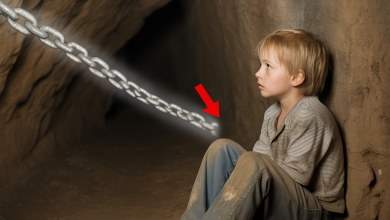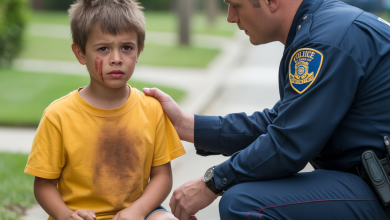The Girl Who Jumped: How a 7-Year-Old's Escape and a Secret in a Teddy Bear Took Down a National Nightmare
It was a Tuesday, just past four in the afternoon, when the intersection of Jackson and Whitmore in a sleepy Tennessee town came to a violent, screeching standstill. The day had been utterly ordinary up until that very second. A light, persistent drizzle fell from a heavy, bruised-looking sky. Cars moved in a dull, weary procession beneath the blinking yellow traffic lights, their drivers tired from work, their minds already on dinner, bills, and the quiet promise of home. And then, in a heartbeat, the ordinary shattered.
From a gray, nondescript SUV speeding through the crosswalk just as the light turned amber, a small door on the passenger side burst open. The vehicle hadn't slowed, hadn't stopped. It was as if the latch had been torn from its moorings from within. There was a flicker of movement, a chaotic blur of pale pink, white socks, and tangled blonde hair, and then a child flung herself out into the street.
She hit the asphalt hard, a small, fragile body against the unyielding grit and gravel. Bare knees skidded, tearing fabric and skin. Horns blared in a discordant symphony of shock and anger. A delivery truck braked with the high-pitched scream of tortured metal. Tires screeched across the wet pavement. For one long, suspended moment, time held its breath.
The child, no more than seven years old, scrambled to her feet with a jerky, desperate energy. Her small hands were scraped raw, bleeding. Her eyes, wide and wild, held a terror deeper than mere fear. It was the look of raw, primal survival.
“Help me!” she cried, her voice cracking, a thin, piercing sound that rose above the cacophony of engines and shouts. “He’s going to kill me!”
For a moment that stretched into an eternity, nobody moved. The scene was too surreal, too violent for a Tuesday afternoon. Then, an older woman, wrapped in a heavy green coat with her gray hair tucked neatly under a scarf, broke from the spell. Her name was Edith Monroe, and she didn't think. She simply acted. She dropped her grocery bag, its contents spilling across the sidewalk, and rushed into the street. She opened her arms, and the small, trembling girl collapsed into them.
Within seconds, the bubble of shock burst. Other people rushed forward. A man with a cell phone already pressed to his ear, shouting their location. A teenager who stripped off his own jacket and handed it to Edith, who wrapped it tighter around the shivering child. A woman in nursing scrubs knelt to examine the girl's bleeding leg. Someone shouted, “Call the police!” But the gray SUV was already gone, swallowed by the river of traffic, disappearing over a distant hill as if it had been a ghost, a phantom that had never been there at all.
What no one in that stunned crowd knew, not yet, was that the child had a name: Lily Thompson. She was seven years old, and she had been officially missing for seventy-two hours. She was last seen leaving her elementary school in Springfield, Missouri, almost four hundred miles from where she now stood, trembling in the arms of a kind stranger.
The footage from the intersection’s traffic camera would soon go viral. News networks would broadcast the grainy, silent clip under breathless headlines like, «BRAVE ESCAPE CAUGHT ON CAM» and «GIRL FLEES ALLEGED KIDNAPPER IN BROAD DAYLIGHT.» But those were just frames, silent, colorless clips that told only a fraction of the story. What the video couldn't capture was the way Lily’s small chest heaved as she fought for breath between broken sobs. It couldn’t show the bright smear of blood on her white socks, the dirt and grime matted in her blonde hair, or the quiet, soul-deep terror that no child should ever have to carry behind their eyes.
Edith didn’t let go. Not for a second. “You’re safe now, sweetheart,” she whispered over and over, her own voice shaking. “You’re safe.”
Lily didn’t answer. She simply clutched the lapels of Edith’s old wool coat and buried her face into the woman’s shoulder, a tiny anchor in a world that had suddenly, violently, tilted off its axis.
Within minutes, the wail of sirens grew closer. Police officers arrived, securing the scene with a practiced, urgent calm. Paramedics gently lifted Lily into the warm, bright interior of an ambulance. One of them, a young woman named Grace, tried to coax a smile from her as she gently applied antiseptic to the girl’s scraped palms. But Lily didn’t smile. Her small body remained stiff, her eyes still watching the street, searching for something, or someone.
“She’s in shock,” Grace said quietly to the police officer standing beside her. “She hasn’t blinked since we got her inside.”
Detective Rainer took a step forward. He was a seasoned officer, nearing retirement, a man who had seen his share of bad endings in a long and wearying career. But something about this girl made him pause. She wasn't just another missing child. There was something else in those eyes—too much awareness, too much weight for someone so small.
“Do we have a name?” he asked, his voice low and steady.
Edith, standing nearby, nodded, her own voice trembling. “She told me. Lily. Lily Thompson.”
Rainer’s head snapped up. The name resonated with the force of a bell toll. “Springfield PD has an Amber Alert on that name. They’ve been looking for her for three days.” He turned toward the paramedics, his voice now sharp with authority. “Get her to the nearest hospital. Keep her under protective watch. Nobody, and I mean nobody, goes near her until I say so.”
That night, across state lines, a mother named Sarah Thompson stared at the news in utter disbelief. She hadn't slept since Friday, her body fueled by a toxic cocktail of caffeine, fear, and adrenaline. The coffee in her hand had gone cold hours ago. Her living room, once a cozy, happy space, was now a war zone of missing posters, scribbled phone numbers, and half-eaten takeout containers. Then, the breaking news banner scrolled across the screen: AUTHORITIES CONFIRM GIRL IN VIRAL VIDEO IS LILY THOMPSON, MISSING FROM SPRINGFIELD, MISSOURI.
Sarah fell to her knees, a sound escaping her throat that was half sob, half prayer. Her daughter was alive.
Long before Lily jumped, long before the sirens and the headlines, the horror began in silence. It began with a pair of pink, slightly worn Converse sneakers sitting by Sarah Thompson’s front door, the rubber soles covered in little hearts Lily had drawn herself with a permanent marker she wasn't supposed to use. Sarah, a single mother and an emergency room nurse, never had the heart to clean them off.
That Friday had started with the familiar, comforting rhythm of their life together. Morning sunlight filtered through the kitchen blinds, striping the floor with gold. Lily sat at the table, her legs swinging under the chair, nibbling at her cereal while humming a tune from her favorite cartoon. Sarah, already dressed in her scrubs, rushed to pack Lily’s lunch: a peanut butter sandwich with the crusts cut off, a banana, two carrot sticks, and a small, hopeful note folded neatly between them. Be kind. Be brave. I love you.
They had hugged before Sarah rushed out the door for her shift. She could still remember the smell of Lily’s hair, a faint, sweet scent of lavender from last night’s bath, and the way her daughter’s small hands barely reached around her waist. It was supposed to be just another shift, a grueling but predictable twelve-hour rotation in the controlled chaos of the ER.
Everything changed at 3:41 p.m. That was the precise moment the school called. Mrs. Howard, the receptionist, sounded unusually, terrifyingly calm. “Hi, Ms. Thompson. Just checking in. Lily isn’t with you, is she?”
Sarah had frowned, a knot of confusion tightening in her stomach. “No, she’s supposed to be in aftercare.”
“She never showed up,” came the reply, each word a hammer blow. “She left her classroom, but no one saw her come to the gym. We thought perhaps you’d picked her up early.”
That moment, that precise, hollow second, was the beginning of Sarah’s personal descent into hell. The next hour unraveled in agonizing, slow-motion increments. Frantic calls were made. The principal searched the halls. Teachers backtracked her last known location. Lily’s classmates offered confused shrugs. One child mentioned seeing Lily talking to a man at the fence before recess ended. Another said she’d gone to the restroom and didn’t come back. The stories were a tangled mess of childhood memory and confusion.
The security footage from the main hallway was grainy, almost useless. But there, at 3:12 p.m., was the unmistakable image of Lily, her small figure walking toward the side exit, alone. Sarah’s legs gave out the moment she saw it. She kept hearing the sound of that side door clicking shut in her head, over and over and over again.
By 6:00 p.m., an official missing person’s report was filed. Springfield PD sent two officers to the house. They were polite, methodical, their questions like sterile instruments probing a raw wound. They asked about custody issues, estranged family members, friends, anyone who might have a reason to take Lily. Sarah offered them names, phone numbers, even the name of the man she’d recently started seeing: Jack. He had been so charming, so kind, so wonderful with Lily. Too kind, perhaps. She realized with a jolt of horror that she didn’t even know his last name.
By 9:00 p.m., an Amber Alert was active, Lily’s smiling school photo flashing on highway signs and television screens. By midnight, Sarah could no longer form coherent sentences. She sat on Lily’s bed, gripping the unicorn pillow her daughter slept with every night. The room still smelled of strawberry shampoo and crayons. Her hand shook as she scrolled through photos on her phone: Lily at the park, Lily blowing out birthday candles, Lily asleep in the back seat of the car. Each image felt like a lie, a postcard from a life that no longer existed.
The house was never quiet after that. It breathed grief into every corner. The refrigerator hummed too loud. The old pipes creaked like whispers in the walls. The silence became unbearable, filled with the ghost of a little girl who had vanished without a trace.
News trucks began parking outside by Saturday morning. Volunteers, strangers with kind, sad eyes, handed out flyers. Sarah stood on her porch, holding a poster with Lily’s face, repeating the story until her throat was raw. The man she knew as Jack had vanished, too. His phone number no longer worked. His email bounced back with an error message. The coffee shop where they had met claimed no one by that name or description had ever worked there. It was as if he had been a phantom, a shadow sent to steal the only light in her life.
By Sunday, hope had become a brittle, fragile thing. Sarah sat in Lily’s closet, surrounded by tiny dresses and a menagerie of stuffed animals, her body folded into itself. She couldn't eat. She couldn't sleep. Each minute that passed without news felt like a fresh betrayal from the universe. And yet, she held on. Because mothers always do. Even when the world forgets, even when the odds turn cold and the search teams begin to thin out, a mother's belief is a stubborn, irrational flame. Sarah whispered her daughter's name into the quiet of the house, over and over, a desperate mantra against the encroaching darkness.
A knock came on Monday night. Detective Rainer stood on her porch, rain glistening on his jacket. He had a strange, unreadable look in his eyes.
“Ma’am,” he said softly, his voice gentle but firm. “We found her.”
Those were the only words she heard before collapsing to her knees, the crushing weight of the past three days finally released in a single, ragged sob. She didn't need the details. Not yet. Lily was alive. And for now, that was enough. It was everything.




